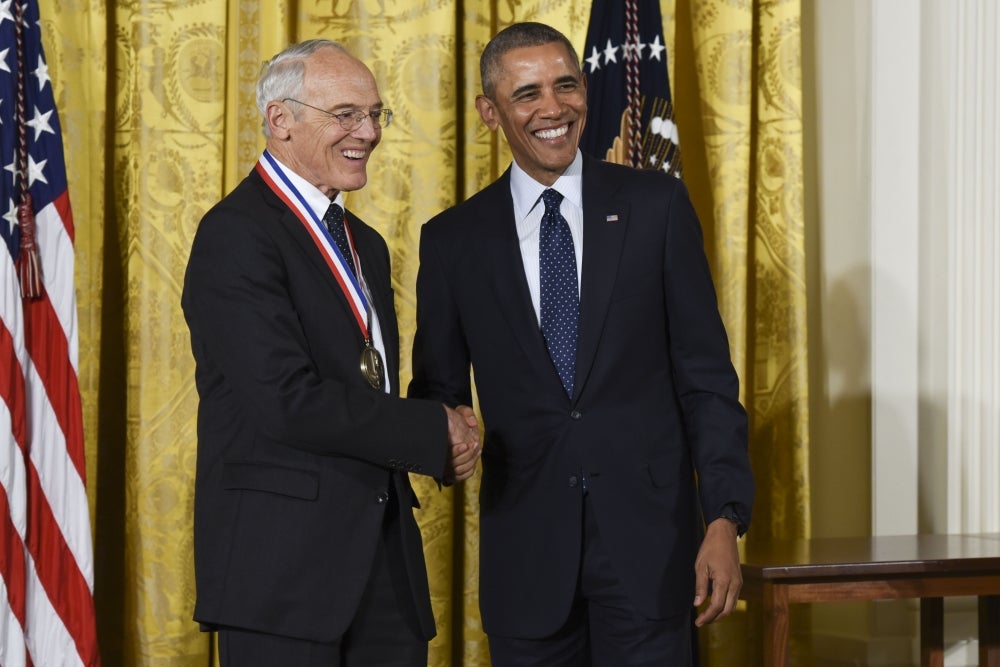
National Honors
In a special ceremony at the White House, President Obama awarded the National Medal of Technology and Innovation to UC Santa Barbara research professor Arthur Gossard. The ceremony took place May 19.
Gossard, a professor emeritus of materials and of electrical and computer engineering, is among eight recipients of the National Medal of Technology and Innovation and nine recipients of the National Medal of Science. Together, the medals represent the nation’s highest honors for achievement in leadership in the fields of science and technology.
“Science and technology are fundamental to solving some of our nation’s biggest challenges,” Obama said when the medal winners were announced late last year. “The knowledge produced by these Americans today will carry our country’s legacy of innovation forward and continue to help countless others around the world. Their work is a testament to American ingenuity.”
The National Medal of Technology and Innovation was created by statute in 1980 and is administered for the White House by the U.S. Department of Commerce’s Patent and Trademark Office. The award recognizes those who have made lasting contributions to America’s competitiveness and quality of life and who have helped strengthen the nation’s technological workforce. A distinguished independent committee representing the private and public sectors submits recommendations to the president.
“I am thrilled and honored to join with our colleagues in congratulating Professor Gossard on his selection for the prestigious National Medal of Technology and Innovation,” said UCSB Chancellor Henry T. Yang. “His creative approach to solving problems, combined with his wide-ranging expertise, relentless curiosity and lifelong passion for frontier-expanding research, has led to remarkable accomplishments that have profoundly influenced the current direction of semiconductor science and technology.
“Mobile phone communications, satellite reception, quantum computation and high-efficiency multi-junction solar cells for electricity generation are just some of the exciting fields that exemplify the rich consequences of his work,” Yang continued. “We are so very proud to see Professor Gossard’s achievements and contributions, especially his pioneering development of molecular-beam epitaxy, recognized in this meaningful way.”
Noted Rod Alferness, dean of the College of Engineering at UCSB, “Professor Gossard’s work in the area of materials growth is at the foundation of groundbreaking scientific and technological advances in semiconductor molecular layered materials. He and his colleagues have leveraged this work to make fundamentally new optoelectronic devices, including the lasers and high-speed electronics that make the global Internet possible. The application of his discoveries and inventions has profoundly touched the daily lives of people worldwide.”
“I am honored to join the group of other scientists, engineers and technologists who have previously received this award,” said Gossard. “I want to thank my family, teachers and colleagues for their huge contributions. And I am pleased by the recognition that the award brings to UC and especially to UCSB.”
Gossard, who joined the faculty at UCSB in 1987, is best known for his research of molecular beam epitaxy (MBE), the growth of quantum wells, superlattices, magnetic semiconductors and metal/semiconductor nanocomposites and their applications to high- performance electrical and optical devices and the physics of low-dimensional structures. He grew the first alternate monolayer artificial superlattices in semiconductors and the first modulation-doped quantum wells.
In the past decade, Gossard synthesized semiconductor quantum structures that allowed quantum coherent manipulation and coupling of electron spins in semiconductor quantum dots. This provided a physical basis for information processing schemes that use two-state quantum systems (quantum bits) to provide efficient computation and secure communication. Gossard also created semiconductor quantum structures in which purely electrically induced electron-spin polarization was discovered.
Among his other important scientific contributions are participation in the formation of Superconductor Technologies, Inc., and the application of high-temperature superconductivity to mobile phone networks and now to large, ocean-based high-efficiency wind turbines for generating electrical power.
Gossard received his bachelor’s degree in physics from Harvard University and his Ph.D. in physics from UC Berkeley. He is a member of the National Academy of Engineering and of the National Academy of Science.



